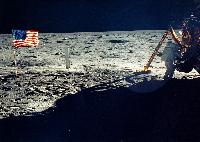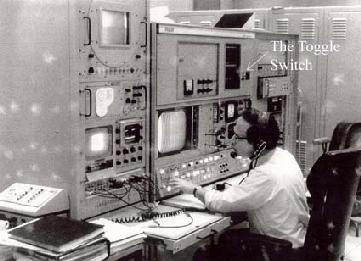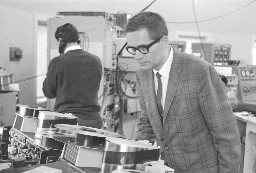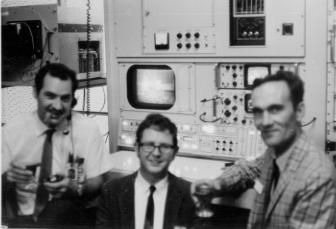
Photo NASA: Neil Armstrong working at the MESA. This is the only high resolution photo of Neil on the Moon.
The Apollo lunar television camera:
The lunar television camera was a black-and-white, slow-scan TV (SSTV) with a scan rate of 10 frames-per-second at 320 lines-per-frame. It weighed 3.29 kg (7.25 lb) and drew 6.5 watts of 24-32 volts of DC power. The camera body was 26.9 cm long, 16.5 cm wide and 8.6 cm deep (10.6 x 6.5 x 3.4 inches). The bayonet lens mount permitted lens changes by a crewman in a pressurised suit. Two lenses were provided: a wide-angle lens for close-ups and large areas, and a lunar day lens for viewing lunar surface features and activities in the near field of view with sunlight illumination.
 Photo NASA: Neil Armstrong working at the MESA. This is the only high resolution photo of Neil on the Moon. |
The camera was also capable of operating in a high resolution mode which was 5/8 frames per second with 1280 lines per frame (non-interlaced). This mode was designed to telecast a high resolution image in case the astronauts were not able to return to Earth with photographs. The camera had a switch located on the top surface that would allow the astronauts to operate it in either mode. Back on Earth, 10-inch monitors with yellow-green high persistence phosphor screens were equipped with Polaroid cameras for shooting directly off the screens. However, because of time constraints this high resolution mode was never used in flight.
The Apollo lunar television camera was built by Westinghouse Electric Corp., Aerospace Division, Baltimore, Md., USA.
Scan-converting the TV pictures:
The TV pictures from the Moon were narrow band slow-scan TV, that is, 10 frames per second (non-interlaced) and 320 lines per frame. In order to broadcast them to the waiting world, the pictures had to first be converted to the commercial TV standards. In the US, the standard was the EIA (NTSC) standard of 30 frames per second (60 interlaced fields per second) at 525 lines per frame. In Australia, the standard was the higher resolution, CCIR 25 frames per second (50 interlaced fields per second) at 625 lines per frame.
 Photo Hamsh Lindsay: The Honeysuckle Creek RCA scan-converter. Ed von Renourd is at the desk. The toggle switch can be seen directly above his head. |
While the TV camera was upside-down in the MESA, the pictures were also upside-down. When Armstrong removed the camera to plant it on the lunar surface, the pictures would be the right way up again. A simple technique was employed to invert the images during the scan-conversion process on the Earth. This involved modifying the scan-converter by installing a toggle switch on its front panel. The switch was connected to the deflection coils of the Vidicon camera by means of a relay, which then inverted the picture by the simple expedient of reversing the vertical scans. Richard Holl, who was a Bendix Field Engineering Corporation engineer responsible for television ground support, helped design and implement the inverter switch.
[Updated: 27 April 2004]: Click here to view a comparison of the image quality from the Parkes SSTV Monitor and the broadcast images captured on commercial black-and-white TV monitors.
The images at Goldstone and Honeysuckle Creek were scan-converted on-site to the EIA (NTSC) standard TV (Honeysuckle Creek only ever had US standard equipment of any kind). The Parkes pictures were scan-converted in Paddington, Sydney, to the NTSC standard also.
When Sydney Video selected the Parkes or Honeysuckle Creek pictures for Houston, the selected signal was split and sent to the ABC Gore Hill studios in Sydney for electronic standards conversion to the Australian CCIR standard. The ABC then distributed the pictures to all Australian networks for broadcast to an estimated audience of 10 million.
In Houston, NASA introduced a six second delay before releasing the TV worldwide. This was to give NASA enough time to cut the broadcast in case an accident occurred to the astronauts - NASA didn't want the world to witness a disaster. The ABC on the other hand didn't have this delay; it broadcast the TV live. Also, because the signal for the Australian broadcast did not have to travel to Houston (via satellite) and then back again as it did for the rest of the world, a further delay of 300 milliseconds was avoided. As a result of these, Australian audiences saw the pictures some 6.3 seconds before the rest of the world.
[Updated 25 February 2009: The six second delay was not in place during the Apollo 11 mission. This statement is now known to be incorrect. The six second delay was in fact introduced during the Apollo 16 and 17 missions and was due to the time required for improving the TV. The 300 millisecond transmission delay was of course in place, so the correct statement should read "Australian audiences saw the pictures some 0.3 seconds before the rest of the world."]
 Photo CSIRO: The 2 inch video tape recorders at Parkes. |
Image Artefacts:
A number of peculiar image artefacts were seen on the images broadcast to the world. One set of artefacts was produced by sunlight reflecting off the astronauts and the LM, directly onto the lens of the lunar TV camera. One prominent bright streak appeared to the right of the US flag. It was a reflection of the bright, sunlit, rear leg of the LM. Whenever the astronauts walked in front of the portion of the picture that coincided with the bright streak, it appeared to be visible through them. These reflections produced the ghostly effects remembered by the public.
Another set of prominent artefacts were small 'white spots' seen in the images scan-converted from the Goldstone and Parkes pictures. These were a result of the optical conversion system. According to John Bolton, following tests of the system the 10-inch monitors were left on and burned spots on their screens. However Ed von Renouard, the Honeysuckle Creek video operator, suggested they may have been reflections from ceiling lights that somehow got into the matte black enclosures of the scan-converters through cracks and other areas. Bill Wood, the Goldstone lead video engineer, thinks they were defects in the targets of the Vidicon camera tubes and Richard Holl, the Parkes scan-converter designer and operator, agrees with him. Whatever their origin, when the images from Goldstone and Parkes were scan-converted, the spots were always present. The Goldstone pictures had a white spot located just below the centre of the screen, whereas the Parkes pictures had the spot located just above the middle of the right hand edge of the screen. The author has not been able to find any such spots on the pictures from Honeysuckle Creek. This has been fortuitous, since it has enabled the author to easily identify the sources of the pictures in the broadcasts of the moonwalk.
An Explosion in the Scan-converter:
 Photo Richard Holl: (L-R) Ted Knotts, Dick Holl and Elmer Fredd standing in front of the Parkes Scanconverter at OTC Paddington following the mission. |
"I repaired or replaced the slow scan monitor, NTSC monitor, camera, disc recorder, power supplies, and Grass Valley video equipment. The camera in the scan-converter was totally fried. The new camera did not have the inversion modification in it. I couldn't take the hardware out of the bad one to modify the new one, so I had to buy all the components in Sydney. I couldn't get the exact relays, so I had to specially design the one for Sydney. It was different to the others. Ted Knotts and Elmer Fredd came over from the USA to help with the repairs. Ted did all the logistics like getting Hewlett Packard in Sydney to fix the waveform monitor and Tektronix to fix the oscilloscope, and getting us the spare parts and tools we needed. Elmer and I would never have gotten it all done without Ted taking care of our needs. I had to perform a lot of magic, but nothing compared to the magic Elmer performed when he started working on the converter logic. I bet we replaced over a hundred transistors (all discrete components) and we were still replacing them while the boys were on their way to the Moon. We made it and so did they".